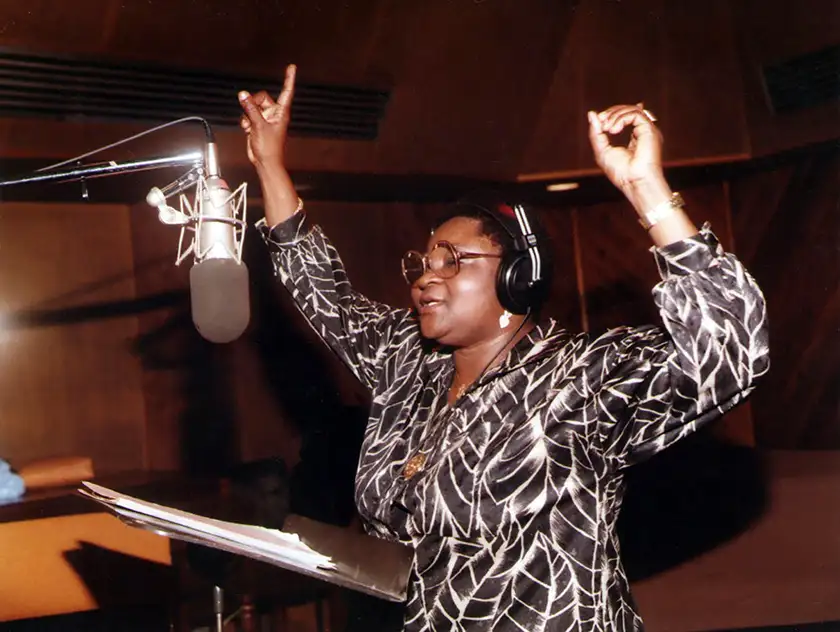The newly restored One Hand Don’t Clap, originally screened in 1991, is a gorgeous documentary about the vibrant history of calypso and soca music.
One Hand Don’t Clap is a beautifully done restoration by Kavery Kaul, featuring Lord Kitchener and Calypso Rose and the sounds of calypso and soca music with the world. Latin rhythms and big personalities are at the forefront of this journey into what seems like a long time ago. Originally debuting in 1991, this new version is in 4K brilliance thanks to the work and funds of the Academy Film Archive, the Women’s Film Preservation Fund of New York, and the Women in Film and Television.
Although this is a documentary about music, it also veers slightly into the same territory as a sports film and the quest for greatness. As part of carnival celebrations every year, there is a “battle” to be named the greatest Calypso singer or Calypso Monarch. In 1978, Calypso Rose was the first woman to take the title with I Thank Thee and Her Majesty. Let it be said that this is not Rocky or Hoosiers, and we’re not watching extended training montages. There’s a retrospective element to her role in the documentary: she’s the now undisputed queen of this genre, looking back and reflecting on her own journey. Conversations that build the film’s narrative and connect it all together are interspersed with the musical performances.
But as much as it is Calypso Rose‘s story, it is also Lord Kitchener’s story and how they work together. Calypso Rose points out herself, “One hand don’t clap,” and the two singers need each other to achieve their greatness. (If you want to keep the musical analogies going, consider the adage, “It takes two to tango.”)
Kitchener is known as the grand master of Calypso, highly responsible for the worldwide spread of the sounds, but especially for the music’s growth and cultural significance in London and the UK. Through the film, Lord Kitchener reflects on his journey as the son of a Blacksmith who used to hammer out and make tunes on his anvil to become a worldwide musical icon and part of the calypso craze.
We meet other characters in the modern quest to be named Calypso Monarch, while elders Calypso Rose and Lord Kitchener look on and give frank appraisals of their stylings as prompted by the documentarians in living room discussions. This is not the setup like that which encourages the cruel barbs of Simon Cowell in American Idol, but instead a lyrical, poetic, and profound assessment of what these young competing Calypso Revue musicians offer. We are tourists to the Carnivale, and as the audience, our opinion of these talents is shaped by our documentary’s two main characters. One Hand Don’t Clap provides us with the privilege of viewing the world through their seasoned musical eyes.

The film doesn’t shy away from political themes either, as music often reflects people’s feelings. From its roots, calypso is grounded in societal turmoil and politics. At one time, it was the language of the oppressed. We see this here in One Hand Don’t Clap. Especially with the sounds of Calypso Rose, we have traditional rhythms with at the time (and still today, it seems) messages about what’s happening in the “modern” world in places like Beirut. The catchy sounds disguise discontent and are a way of processing it all through a lens that allows you, the listener, to retain hope. It’s through Lord Kitchener’s journey, however, that we are exploring the politics of the past. But instead of being a rigid proponent against change in the sounds that made him a household name, Kitchener embraces the fast soca sounds that sell records. We experience the evolution of sounds in this film.
There is also a novelty to this restoration that perhaps wasn’t there in the 1991 version: we are about 33 years from when their steel drums were first on screen, and the world is different. One Hand Don’t Clap is a 4K time capsule to technology and community that no longer exists. It’s a celebration of rhythm and musical art. It’s also an important exploration of the calypso’s historical significance. For that and other reasons, this restoration is a great service to the world and worth checking out.
The new 4K restoration of One Hand Don’t Clap will open in New York (BAM) on March 8 and in Los Angeles (Laemmle Theaters) on April 8

